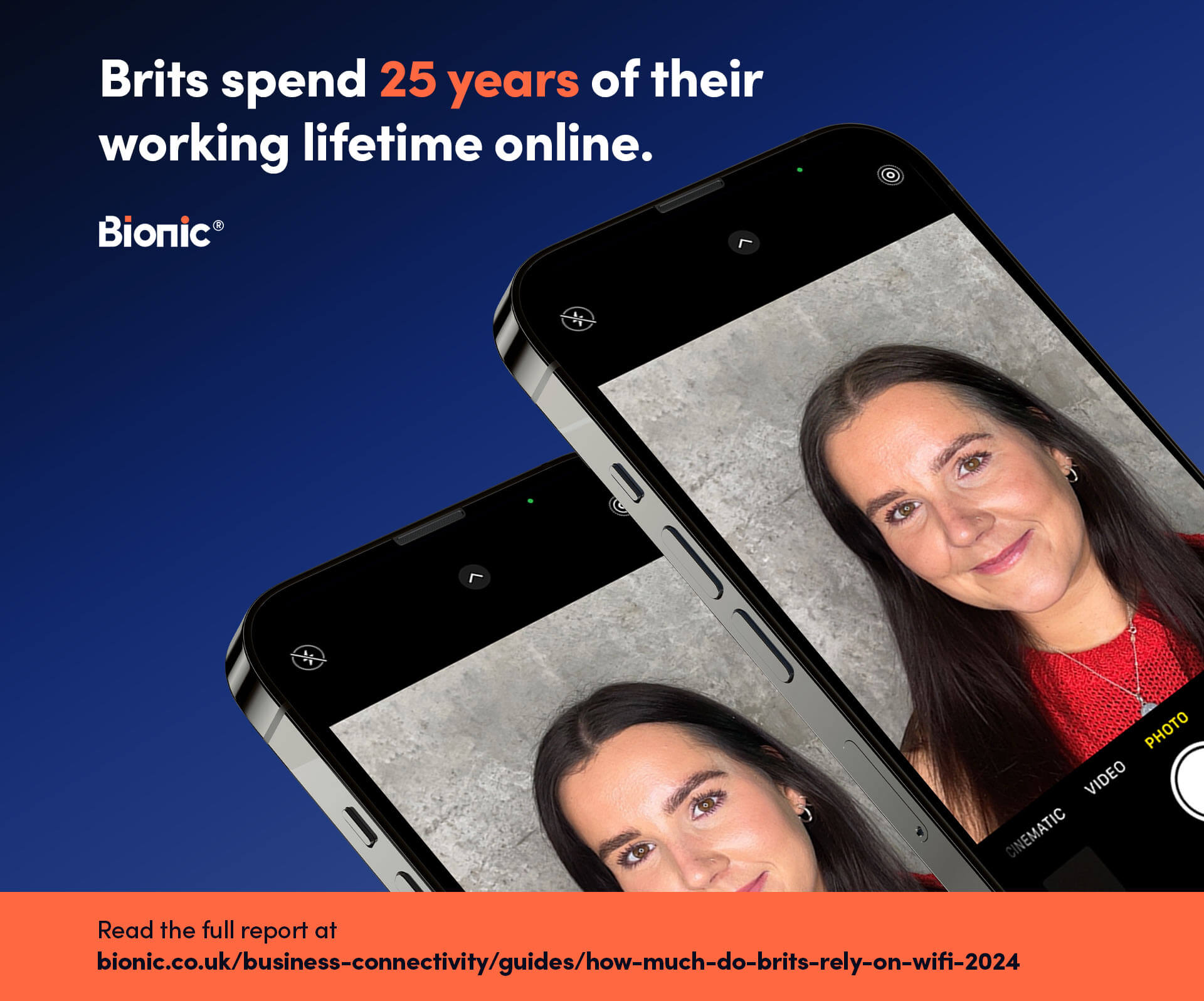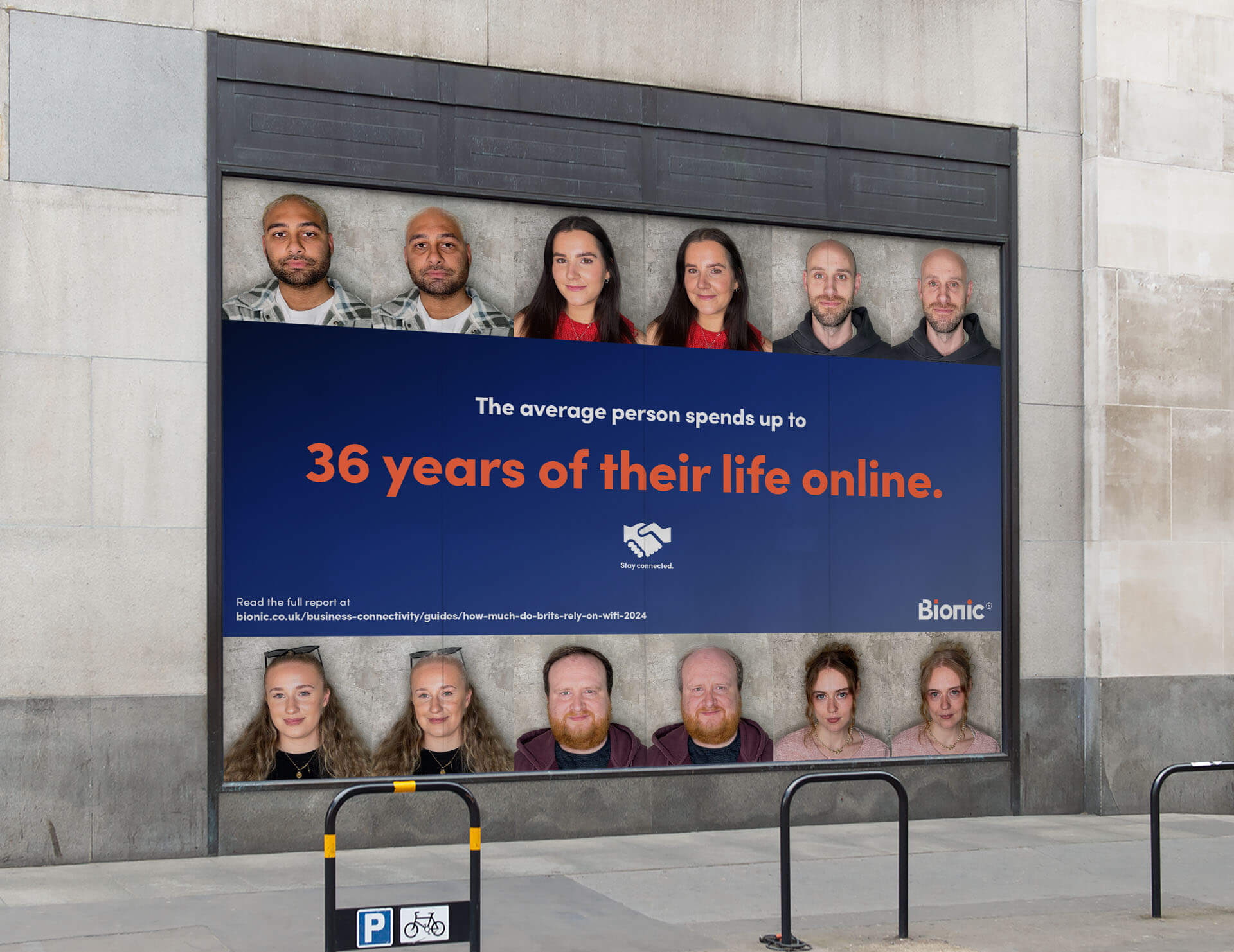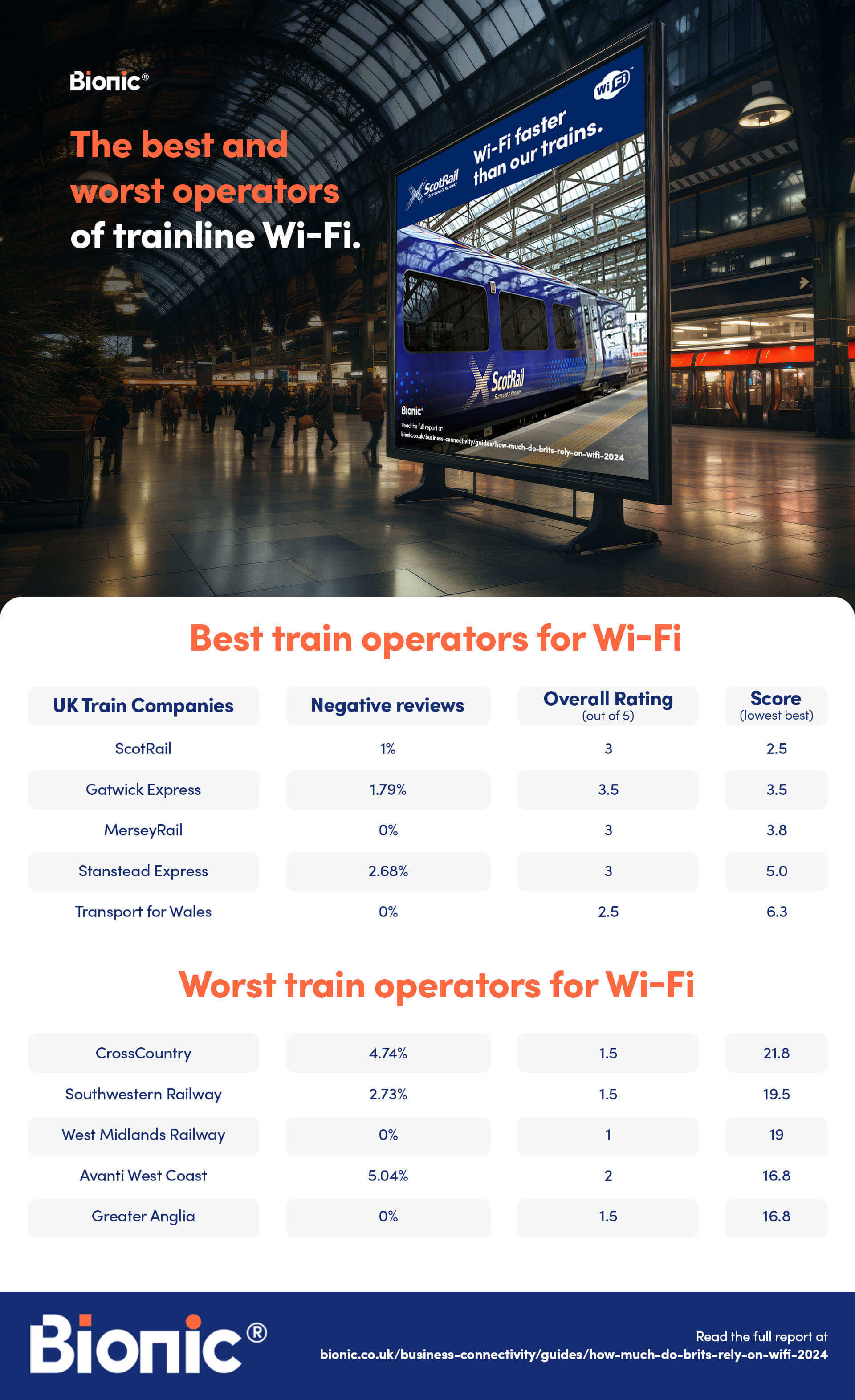How much do we rely on WiFi?
WiFi is no longer a luxury — it's a necessity. From the moment we wake up to the minute we go to bed, we rely on the internet for (almost) everything, from work and entertainment to keeping in touch with loved ones. Since COVID-19, its importance has soared to new heights, enabling remote work, powering entertainment, and driving small businesses forward through connectivity.
But just how reliant are we on WiFi?
Bionic has discovered the extent of our dependency on connectivity by investigating how much time the average person spends online over a lifetime. We delved into the importance of WiFi in our day-to-day lives, covering activities from work and school, to travelling on trains and planes.
We analysed recommended and reported screen times across different ages and generations to determine exactly how much time we are spending online. This data highlighted our dependence on constant connectivity, expecting to stay online even when travelling across the country and the world.
In light of this, we looked into what the best providers for onboard WiFi are for those travelling by trains and planes, whether for business or leisure.
How much screen time does the average Brit consume?
Screen time is how long you spend glued to electronic devices like phones, tablets, computers, and TVs. We all love our screens, right? They keep us entertained, connected, and informed. But like everything in life, too much of a good thing can sometimes be, well, not so good.
So, how much is too much? In the UK, there aren't strict rules about how much screen time is "allowed" for adults like there are for kids. However, experts suggest aiming for a healthy balance. That means making sure you're not spending all day, every day, in front of screens. Taking breaks, getting outside, and engaging in activities that don't involve screens are important.
By the time someone is 65, they will have spent over 27 years of their life online
By looking at medically recommended and reported average UK screen time data across different ages, we’ve discovered that the average adult spends 76% of their waking hours online. By the time someone is 65, they will have spent over 27 years online- now, that’s a very long time! Our high screen time is largely a result of our lifestyle and working patterns, as so much of our habits and activity revolves around our screens, from working on laptops to scrolling social media to stay connected, and even streaming series to relax.

During adulthood, Brits will spend 223,015 hours online throughout their career. This equates to 9,292 whole days, or 25 years!

If we consider the average British life expectancy of 81 years, the average Brit will spend 312,805 hours online, which equates to almost 36 years, another decade online just in retirement.

Recent Ofcom research suggests that nearly a quarter of five to seven-year-olds have a smartphone, and screen time doesn’t seem to be decreasing for future generations anytime soon…
However, Gen Alpha faces the highest screen time of any other group. In line with their ‘iPad kid’ personas, they will have the highest average lifelong screen time of any other group. Thanks to growing up online and even using computers in classes at school, today’s kids are looking at spending, on average, 37 years of their lives online, which is more than 46.6% of their entire lifetime or 65% of their lifetime that they are awake.

Although the length of time adults spend online may sound scary, it’s a simple fact that in today’s society, WiFi is essential for most jobs. So what about when you need to be connected for work while on the move?
WiFi while travelling
Picture this: you're on a train, your laptop open, trying to catch up on emails or prepare for that big presentation. But oh no, the WiFi is spotty at best, and your signal keeps dropping. Sound familiar? Think about all the valuable time and opportunities lost because of unreliable WiFi on trains and other public transport. That time spent twiddling your thumbs, waiting for pages to load or emails to send could be better spent brainstorming ideas, closing deals, or simply getting ahead on your workload.
It's not just about individual frustration—it's also a real blow to businesses. Imagine the collective hours wasted by employees across the UK grappling with poor WiFi connections during their commutes or business trips. It adds up, and it's not just a minor inconvenience—it's a significant loss in productivity and efficiency.
In a world where every minute counts, businesses can't afford to overlook the importance of reliable connectivity, especially for employees who are constantly on the move. This includes ensuring smooth virtual meetings, facilitating real-time collaboration, and allowing employees to maximise travel time.
The train operators with the worst WiFi connectivity

We looked at what proportion of each train operator's reviews included a negative sentiment about the WiFi onboard, and the overall rating of each train operator online to create a ranking, where the closer the total score is to one, the better the onboard connectivity will be for customers.
ScotRail has the best WiFi connectivity in the UK
ScotRail has the best-rated WiFi of all the UK’s train operators, with the lowest complaints score compared to its fellow companies. Scotland's national railway line has just one negative review of their WiFi and had an overall rating of 3 out of 5, which gave them a score of 2.5.
Gatwick Express has the second-strongest connectivity onboard
The Gatwick Express ranks in second place, with a score of 3.5. Only 1.79% of the airport railway’s online reviews included a negative sentiment about the onboard WiFi, and the online overall ranking also gave the line a 3 out of 5, which contributed to its high ranking. Online reviewers commented that the “WiFi worked pretty well” and was pretty reliable. But this cannot be said for all customers.
Cross Country has the worst-rated onboard WiFi in the UK
Cross Country trains have the worst-rated WiFi in the UK, with the highest score of 21.8. This poor score is a reflection of the 4.74% of reviews that include a negative sentiment towards the WiFi performance, and the low overall review of the train operator, which only sits at 1.5 out of 5. Online reviews detail that the connectivity on board is “very poor” and “just DOESN’T WORK", which explains why it sits at the bottom of our list.
Why is WiFi so bad on trains in the UK?
If you have a busy day ahead of you, it is a good idea not to rely too heavily on being able to work from the train. Instead, schedule your day around your travel plans, as WiFi on trains in the UK is as notoriously unreliable as the train timetables, so it is unlikely you are going to be able to tick many things off that to-do list.
The reason behind this is due to the geographical challenges the landscape offers, from tunnels and rural areas leading to poor signal coverage and the need to frequently switch between cell towers. Infrastructure in the UK is limited and there are insufficient trackside boosters and antennas reducing connectivity capabilities. Upgrading this is extremely costly and complicated, and would still have varying levels of service quality across different train operators. To solve this, train operators and mobile network providers have to work together.
The airlines with the best and worst WiFi
Many businesses require international travel, and for many long-haul flights, you need to be able to work while travelling across the globe. But which airlines give you the best in-flight WiFi and which leave you disconnected from the world?

By analysing the download speed, pricing packages and ranking of onboard entertainment (including WiFi) of the biggest airlines currently offering in-flight WiFi to discover the best and worst Airlines for those who need the internet to work while flying. The closer the score is to one, the better the onboard WiFi.
JetBlue has the best in-flight WiFi of all airlines
JetBlue has the highest rated onboard WiFi with a top score of 2.6. This is thanks to a high entertainment rating online of 4 out of 5, average WiFi speeds of 20Mbps, and the package being free for all customers. Online reviewers reported that the “free WiFi worked great” and that it was a “great surprise” as it can often come with a hefty price tag on other operators.
Hawaiian Airlines is the second-best airline for onboard connectivity
Hawaiian Airlines ranks second with a score of 3.8. The airline has an entertainment rating of 3.5 out of 5 and has even faster download speeds than JetBlue, at 100Mbps. Hawaiian Airlines also provides this for free for its customers, meaning they can continue with any urgent work or even just stream movies while on board. Customers were pleased to see they had “WiFi the entire flight”.
Philippine Airlines has the worst airline WiFi
Philippine Airlines came in last place in our ranking, with a poor score of 19.8, meaning it has the worst WiFi of all airlines analysed. Its poor online rating of its entertainment and WiFi only ranked at 2.5. Although not the lowest of the airlines, the WiFi speed only reaches 7 Kbps, which means flyers are left unimpressed by the offering. Most reviewers advised other customers to just expect the onboard WiFi not to work at all.
Why being connected is so important today
The internet is essential, especially for work. It became even more crucial during the pandemic, helping businesses survive by enabling remote work and online connections. In modern society, the internet is almost as essential as food and shelter, meeting our basic needs for communication, information, and connection.
How to stay secure and safe online
There are numerous ways to stay connected securely and safely:
- Strong passwords: Use unique, complex passwords for each online account and consider using a password manager to keep track of them.
- Update software: Keep your devices and software up to date to patch any security vulnerabilities.
- Use HTTPS: Look for the padlock symbol and "https://" in the URL when browsing the web, especially for sensitive sites like banking or shopping.
- Beware of scams: Be cautious of suspicious emails, messages, or links, and never give out personal information unless you're sure it's safe.
- Secure WiFi connections: Avoid using public WiFi for sensitive activities like online banking. If you must use public WiFi, consider using a virtual private network (VPN) for added security.
- Enable two-factor authentication: Enabling two-factor authentication, which requires a second form of verification in addition to your password, adds an extra layer of security to your accounts.
We know how important WiFi connectivity is in everyday life and work. Compare business broadband prices today.
Methodology
We analysed the average screen time recommended for different age groups from 2 to 81 years old, on top of the reported average screen time for adults, which is 13.2 hours a day, compared to the average number of hours awake each day.
To look at the best and worst airlines' WiFi connectivity, we looked at the number of complaints online about each airline that included negative sentiments about the WiFi onboard, compared to the total number of reviews about the airline and indexed this alongside the pricing structure for the WiFi packages offered, all found using review platforms and the operator's own website.
For the best and worst train line WiFi’s we used the total number of negative WiFi reviews out of the total number of online reviews, analysed alongside the operator’s overall review out of five. For the rankings, the closer the score is to one, the better the onboard connectivity is, ie for WiFi on trains, if a train operator has a score of one, they have zero negative reviews of the WiFi onboard, and the operator has a 5/5 ranking overall online.








